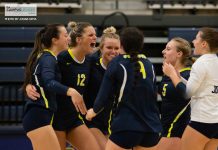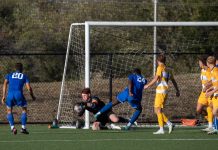Barrett Emke is an experienced freelance photographer. One of his recent photographs of the Ferguson protests was listed in Time Magazine’s Top 100 Photos of 2014.
The protests in Ferguson started happening back in August, and that’s when Emke first went there. He wasn’t working for any publication at the time and was only there for a few days, although he went back twice, once in September and then in November when the court’s decision was announced.
The first time Emke traveled to Ferguson, he felt slightly nervous, though not scared. He felt compelled to be there and cover what was going on for a multitude of reasons.
“On one hand, it felt like an opportunity to go document something that would matter historically. I didn’t want to miss that. Whatever was happening felt like it was going to be significant for years to come,” he said. “I just sort of felt this urge like I needed to be there in some aspect. I just felt like a drive to go there.”
For the first two trips, Emke traveled to Ferguson for his own documentation purposes. However, in November he covered the protests as a hired freelance photographer for Time Magazine and Esquire.
“The third time I went, [the community] seemed very weary by this constant media presence in their city. It just seemed to really wear down on people. It’s an interesting thing. I don’t necessarily know what the situation would be or is,” he said.
Additionally, Emke talked about what it felt like to have his work recognized by Time Magazine.
“It was a super big honor for me. It definitely felt like a milestone. What I had shot for him specifically was the night after the announcement, and that photo was from the weekend before, [which was] a protest leading up to that.”
Going into Ferguson, Emke already had prior knowledge documenting events and people through his photography. He graduated from KU in 2011 with his degree in photography.
However, Emke enrolled in a large-format photography class with Adjunct Instructor Philip Heying to further his knowledge during spring 2014. Large-format photography is an older form of photography that is rather “strenuous,” according to Emke, and requires the photographer to load each negative after every shot. However, Emke knew Heying through previous networking.
“He is a friend of mine. I actually met him when I was at KU. He came to visit one of my classes and talked about his own work. One of my instructors invited him to come talk to us about his career,” he said. “I shared my work with him and he gave me a lot of good advice when I was still in school.”
Emke said that sometimes he will slow down and think about his photograph beforehand, just as if he were working with a large-format camera again. However, sometimes in photojournalism, he doesn’t always have the chance to slow down and think about the photo.
“I have realized that you can work and sort of take that large-format aesthetic or mindset even when you’re shooting a subject that might be very news oriented,” he said. “It really helped me to re-train or further train my eye to get the shot you really want.”





















